Gea Elika's Blog, page 176
February 4, 2015
520 Park Avenue
If the address 520 Park Avenue sounds familiar, it’s probably because you’ve read about this building online or in a newspaper. The reason 520 Park Avenue has received so much media attention is because this address is home to the priciest apartment in New York. But even if you don’t plan on purchasing the penthouse for $130 million, there’s still a lot to like about the other thirty apartments in this building.
Architecture
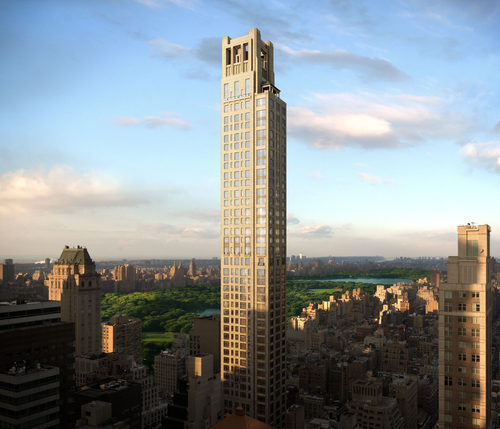
Standing 54 stories tall, this Indiana limestone building is a remarkable sight. With the location of its entrance at 60th Street between Park and Madison Avenue, 520 Park Avenue makes every arrival a delight. Inside the building, both guests and residents will marvel at the collection of beautifully articulated and intimate spaces that come together to form the lobby.
Residences

In New York’s competitive and crowded real estate market, finding full-floor residences can be a big challenge. But at 520 Park Avenue, every residence offers a full-floor setting. With classic layouts that boast modern touches, the experience of being in one of these residences is truly unforgettable.
Whether it’s the dining room or formal living room, entertaining spaces are accentuated with soaring ceiling heights. For personal spaces, residents can enjoy master suites that feature two en-suite master baths. Each suite also has a dressing room. Not only are the baths clad with gorgeous marble, but they offer incredible views of New York City.
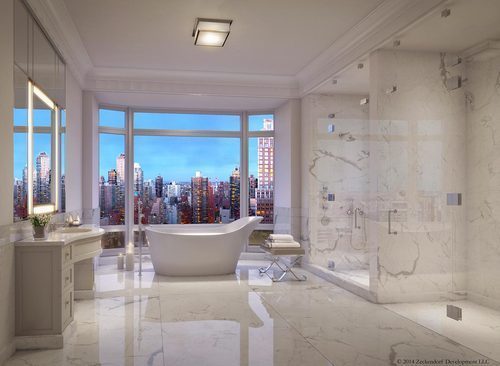
Those views extend throughout the rest of the residences, and include both the Upper East Side and Central Park. When it comes to luxury, 520 Park Avenue delivers on every front. Although prices haven’t been confirmed, they’re expected to start in the $16 million range.
Amenities

On the long list of what this building has to offer, its salon is first on the list. This quiet space is the perfect spot to enjoy thoughtful conversations with others. 520 Park Avenue also has a private garden for residents. Featuring classic landscaping, this relaxing space is complete with beautiful fountains.
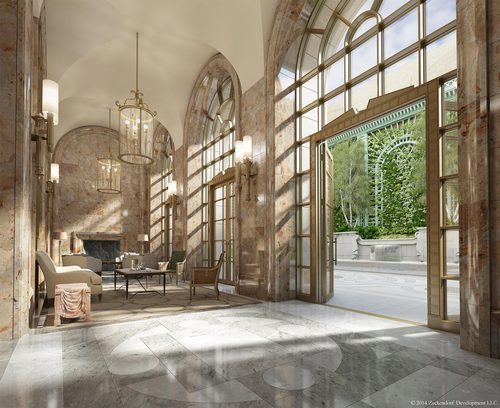
Next on the list is the building’s immaculate pool. There’s also a fitness center with multiple exercise rooms, as well as a treatment room. The building’s suite of fitness services includes sauna and steam rooms. The list of amenities is rounded out by available storage, a wine cellar, guest suites and a children’s playroom.
Neighborhood
As 520 Park Avenue’s official website states, the neighborhood where this building is located evokes “privacy, prestige and success unlike any other.” Amazing restaurants, elegant shopping and surroundings that include some of the city’s best pre-war architecture are just a few of the benefits you’ll enjoy living in this building. An added bonus of its Upper East Side location is that 520 Park Avenue is comfortable nestled between two different parks.
[ 520 Park Avenue ]
The post 520 Park Avenue appeared first on | Elika Real Estate.
February 3, 2015
NYC Loft Living: 5 Spaces to Inspire
Loft living could be considered the ultimate luxury. A low-maintenance lifestyle combined with wide-open space –– a rare amenity in New York City –– keeps loft apartments in demand while garnering high prices. Neighborhoods known for loft buildings include SoHo, TriBeca, Chelsea, Williamsburg, and DUMBO, but loft-like apartments can be found throughout much of the city.
True lofts are typically characterized by tall ceilings, structural columns, large windows, exposed pipes, concrete or wood floors, and no interior walls. Many warehouse lofts in NYC were once just that –– warehouses –– and have been converted to residential dwellings. In the 1960s and ‘70s, artists set up live/work spaces in many SoHo buildings, which have since been converted to condos or co-ops. These apartments are usually the most desirable.
“Hard lofts” often refer to those that were once commercial or had another use, but later converted to residential. “Soft lofts” usually refer to those built as residential units only.

Contemporary Dining Room by Shelter Island Architects & Building Designers SchappacherWhite Architecture D.P.C.
Decorating a loft apartment has its challenges. Maximizing the space without destroying the loft’s elegant details is essential and often requires hiring an architect, interior designer, or both to come up with the most functional design scheme.
I found the décor in these five NYC loft spaces inspiring, and I hope you will too.
Thomas O’Brien designed this home with a neutral palette and successfully married modern and classic furnishings. Splashes of chocolate and black with loads of texture keep this space from ever feeling bland. Notice how the loft floods with natural light. And the fireplace? What a bonus.

Modern Dining Room by New York Media & Bloggers ABRAMS
This stunning loft in SoHo’s Cast Iron District boasts an open space with designated areas –– living, dining, and office. A kitchen hides neatly behind a partition wall, while elements such as wood flooring, built-in bookshelves, modern art, and undressed windows define the generous space.
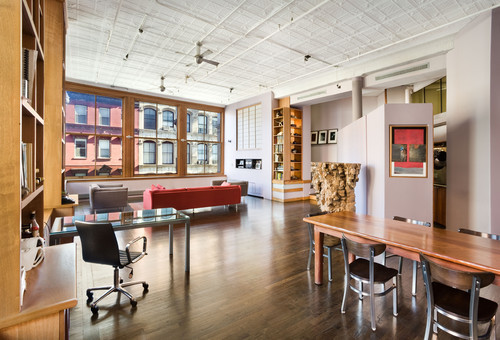
Industrial Living Room by New York Photographers Vanni Archive/Architectural Photography
A loft on Park Avenue –– who knew? An oversized island creates a focal point in this spacious loft apartment. Ideal for prepping and casual dining, the island separates the kitchen from the living/dining room. Unusually tall windows, exposed beams, and an eclectic mix of collectibles make this space grand yet comfortable. A white backdrop leaves plenty of room for color in the accessories. This apartment is appropriate for a couple or family.
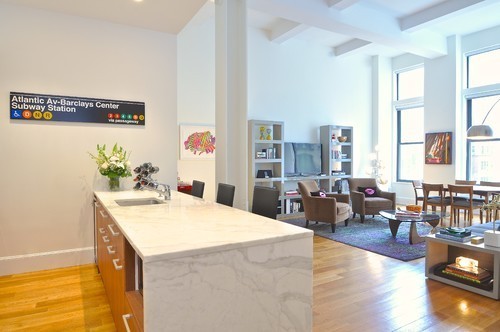
Transitional Spaces by New York Architects & Building Designers B.A. Torrey Interiors
This Jay Street loft feels primitive and modern at the same time. Reclaimed gray wood, black steel accents, floating wall shelves, ebonized flooring, and a custom home office space, complete the TriBeCa home.
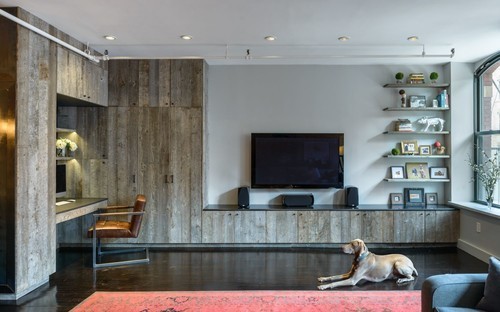
Industrial Living Room by New York Architects & Building Designers Jane Kim Design
A stark contrast between light, medium, and dark finishes in this Hudson Street loft pleases the eye. Located in the former American Express warehouse building, the architect combined two spaces to form the 3,000 square foot apartment while maintaining the industrial feel.

Contemporary Kitchen by Shelter Island Architects & Building Designers SchappacherWhite Architecture D.P.C.
The post NYC Loft Living: 5 Spaces to Inspire appeared first on | Elika Real Estate.
January 30, 2015
Neighborhood Spotlight: Brooklyn Heights
With its cobblestone streets, signature brownstones, former carriage houses and stately mansions, Brooklyn Heights is one of the most coveted neighborhoods in the borough if not the entire city. “Graceful” and “elegant” are words often used to describe this parcel, also referred to as “America’s First Suburb.” The upscale neighborhood draws young families and professionals because of its character and relaxed lifestyle, yet easy access to Manhattan.
The neighborhood
The area is about five blocks wide and 12 blocks deep. It’s bordered by the East River to the west, Cadman Plaza and Court Street to the east, Old Fulton Street to the north, and Atlantic Avenue to the south. Adjacent neighborhoods include Cobble Hill, DUMBO, Downtown Brooklyn, and Boerum Hill.
The Brooklyn Heights Promenade provides panoramic views of Manhattan and New York Harbor, including the Statue of Liberty. At one-third of a mile long, it’s a fantastic spot to stroll, jog, or relax. The promenade became famous in the films Moonstruck and Annie Hall.
Famous faces have populated the nabe for years, and star power remains prevalent to this day. Celebrity residents have included Lena Dunham, Javier Bardem and Penelope Cruz, Paul Giamatti, and Keri Russell; while renowned writers such as Norman Mailer and Arthur Miller have perfected their craft at home in Brooklyn Heights.

Things to do
Brooklyn Bridge Park has become one of the highlights of the neighborhood. With its 85 acres of public green space, volleyball courts, playgrounds and a carousel, the park draws locals as well as New Yorkers from the other boroughs. Montague ––the main street –– boasts its share of ethnic eateries such as Café Buon Gusto for Italian, Gallito’s Kitchen if you’re in the mood for Mexican, and Hanco’s for Vietnamese.
Venture closer to Atlantic Avenue and you’ll discover quaint, quiet Columbia Place, home to Iris Cafe, one of Brooklyn’s most interesting culinary finds serving Nouveau-American cuisine.
Don’t miss Jack the Horse Tavern on quiet Hicks Street, or to satisfy your sweet tooth, try Ample Hills Creamery on Joralemon.
Although not a shopping destination, Brooklyn Heights has its share of independent and chain stores. You’ll find staples like Sephora, Banana Republic, and Jacques Torres, as well as local favorites like Bentley’s Shoes, Housing Works, and A Cook’s Companion.

Transportation
The subway is convenient and minutes to downtown Manhattan. You can catch the A, C, F, N, R train at Jay Street, the 2 or 3 at Clark Street, and the 2, 3, 4, 5, A and C trains at Borough Hall.
What it costs

Although Brooklyn, the neighborhood comes at Manhattan prices. Expect to pay approximately $2,500 to $3,000 to rent a one-bedroom apartment. Two-bedroom apartments sell for an average of about $1.5 million, with a few on the market for less than $1 million and other prices hovering closer to $2 million. Despite the high cost of living in Brooklyn Heights, according to Streeteasy.com, just six one-bedroom properties are currently listed, ranging from $629K to just over $1 million. The lack of inventory supports the theory that many people have a desire to live in the neighborhood.
The post Neighborhood Spotlight: Brooklyn Heights appeared first on | Elika Real Estate.
January 28, 2015
Economic Outlook: Fueled by Gas
The start of the year is an ideal time to offer our economic view. Many signs continue to point upwards. A key consideration is the labor market, which has been steadily improving. We will leave it to others to examine the impact of the precipitous decline in crude oil prices on certain states, such as Texas and North Dakota, In terms of New York City, it is likely to be beneficial. Gas prices have plummeted, fattening wallets and give consumers more dollars to spend.
Stronger economy leads to job growth

The economy has showed signs of steady improvement. In the latest estimate, third quarter GDP rose a strong 5%, up from 4.6% in the second quarter. Although the harsh winter in 2014 shaved growth from the first quarter, which fell 2.1%, the latest data show it was merely a temporary blip. Moreover, the growth rate has increased. In the second half of 2013, GDP expanded by 4.5% and 3.5%, in the third and fourth quarters, respectively.
The accelerating economic growth has led to increased jobs. The nadir on jobs was in early-2010. Since then, more than 11 million private sector jobs have been created. In 2014, an average of about 250,000 new jobs were created each month. The unemployment rate fell to 5.6% in December, down from 10% in October 2009.
We expect the improved employment picture to continue this year. Businesses appear to have more confidence. This is showing up in increased investment. After plummeting during the recession, it has spiked upward, at better than 5%. Similarly, profit margins have jumped since the recession. It has gone from 5% to about 10%, according to the Bureau of Economic Analysis. However, it has drifted slightly lower, but lower oil prices may fuel improvement going forward.
Wage growth will need to pick up. The increased employment has not translated int higher wages, yet. The average hourly wages were $10.31 in January 2014 and stood at $10.40 in December. However, as the labor market tightens, we expect workers’ pay to rise as competition heats up and employers become more anxious to fill openings.
Low gas prices fatten wallets
Crude oil prices have fallen by more than 50% since June. This has led to gas prices falling. Nationwide, the average price for regular unleaded gas has declined by 38% to $2.04 a gallon over the past year.
The average family is expected to spend $750 less on gas this year, according to the Energy Information Administration (EIA), an arm of the Department of Energy. This is essentially a tax cut, and will stimulate the economy. Consumer spending represents two-thirds of GDP and is therefore an important component of the economy.
Mortgage rates remain low

The stronger economy makes it likely the Federal Reserve will raise short-term interest rates. It appears the Fed will increase rates sometime this year. The Fed Funds rate has been held near 0% for several years, an unusual circumstance.
However, most mortgages, particularly the 15 year and ever-popular 30 year fixed, are based on longer-term Treasury yields. Although the Fed helped keep these rates low, it has ended the program known as quantitative easing in October. Many, particularly those shopping for a home were concerned.
Treasury yields have remained low. We attribute this to the lack of inflation, and the outlook will be helped by falling crude oil prices. The 10 year Treasury yield stands at 1.83%. Last year, the yield fell from 3% to 2.17%.
Conclusion
The housing market is poised for another strong season heading into the spring. Although the European economies are weakening, and Russia is going through turmoil, we do not see U.S. growth greatly impacted. These countries are not large trading partners of ours and slower growth overseas does not meaningfully impact GDP growth, historically.
Meanwhile, the economy is gaining strength, with an improved employment picture and greater consumer spending power.
The post Economic Outlook: Fueled by Gas appeared first on | Elika Real Estate.
January 27, 2015
6 Reasons Why New York Is One of the Most Livable Cities
What makes a city livable? For me, it’s convenience and variety, among other things. For others, it’s job availability or access to cultural events and fine food. Life in New York offers all of the above, and you’ll never run out of options to explore.
Regardless of what you think makes a city livable, you can’t deny these six things, all of which make the Big Apple one of the most livable cities in the world.

1. You can walk everywhere.
Particularly in Manhattan, but even in many areas of all five boroughs, the city is walkable. Wide sidewalks, crossing signals at intersections and strategically placed train stations make NYC one of the most pedestrian-friendly towns you’ll find on the planet. Just don’t forget to wear comfortable shoes.
2. The 24-hour lifestyle
Whether you have a hankering for a steak dinner, crave a dry martini or you’re in desperate need of a French manicure, you can do most anything in NYC around the clock. Manhattan is particularly known as “The City that Never Sleeps,” and for good reason. From late-night movies to taverns and nightclubs, night owls will feel right at home in Gotham. And if you happen to be up at 3am, you can also go grocery shopping at one of the many all-night supermarkets, or grab necessities at one of the 24-hour Duane Reade locations.
3. Access to public parks
New York may be far from rural, but the city’s parks offer a splendid getaway and reprieve from the hustle and bustle. In fact, spending time in parts of Central Park, Riverside Park, Fort Tryon, and many green spaces in the outer boroughs, might leave you wondering if you’re in the city at all.

4. Diversity
New York is one of the most diverse places on the globe. Often referred to as a “melting pot,” the city’s people hail from countries around the world and collectively speak more than 800 languages. Being exposed to a variety of cultures only enhances the lives of the city’s denizens. Children are raised with more tolerance and naturally accept the differences from one culture to another. Riding the subway is a terrific way to get a sense of just how diverse the city is. Scan a single car and take note of the uniqueness of each passenger.
5. Public transit
New York City’s subway system is the largest in the world with 232 miles of routes and the highest number of stations. By ridership, the NYC subway is the busiest in the United States, and the seventh busiest in the world, averaging 5.5 billion rides on weekdays. Trains operate 24 hours a day and 365 days a year.

Buses are also an integral part of the city’s transit system. With a daily ridership of 2.2 million, some New Yorkers prefer to commute above ground even if their commute times are longer. Having the option of riding the bus or subway as well as taking taxis, and now the increasingly popular CitiBike make New York an even more livable city in the new millennium.
6 Opportunity
As of 2006, more US citizens wanted to live in or near New York City than any other city. Besides its excitement, pedestrian-friendly streets, array of public parks, variety of things to do, and the advanced public transit system, people come to New York for career opportunities. New York City offers a multitude of options no matter your demographic. The endless possibilities continue to make New York one of the greatest and most desirable cities in which to live.
The post 6 Reasons Why New York Is One of the Most Livable Cities appeared first on | Elika Real Estate.
January 23, 2015
The Dreaded Flip Tax: What You Need to Know
You’ve probably heard the term “flip tax” mentioned in conversations that involve buying and selling New York City real estate. This tax, which is a transfer fee and not deductible as a property tax, is one that is typically paid by the seller and sometimes the buyer of a NYC co-op or condo.
Flip taxes are rare in other places but have been assessed in New Jersey, although they’re referred to differently. These dreaded fees are a way for your co-op or condo to say, “Thanks for staying with us. We hope you enjoyed your time here, now pay up before you leave.”
Below are some of the most asked questions about flip taxes.
How long have flip taxes been around?
These creatures got their start in the 1970s and 1980s when rental apartment buildings started converting to co-ops. Many structures were in disrepair and cost thousands to renovate. After which, tenants could sell their units turning a large profit, but the building was stuck with the debt from rehab. The flip tax was created as a way for the co-op to recoup the improvement costs, so the building had reserves to fund its ongoing operating expenses.
Are flip taxes legal?
A flip tax must be written into a co-op’s proprietary lease to be legal. If not verbalized in a lease, two-thirds of the shareholders must approve the imposition of the flip tax.
How much is the tax?
The percentage of tax depends on the building. Most often, a flip tax is 1-3 percent of the sales price. (At 3 percent, a $1,000,000 apartment’s transfer fee would be $30,000.) But a flip tax can also be calculated based on the amount of shares set aside for the apartment; a percentage of the sales price or net profit of the sale; as well as a percentage based on the length of time the seller has owned the apartment.
What’s the point of imposing a flip tax?
As mentioned above, the profit goes directly to a co-op’s
operating expenses. The point is to avoid assessments and maintenance increases for the shareholders. With thousands of dollars in reserve funds, if the building requires a capital improvement project, often the flip taxes from past sales can pay for the project in full, or at least a good part of it. In turn, the maintenance fees won’t need to be increased, and assessments wouldn’t be necessary either.
Is there any way I can get out of paying it when I sell my apartment?
Unfortunately, no. You’ll have no choice but to ante up for this transfer fee when you go to sell your co-op. There is the possibility that you could purchase an apartment in a building with no flip tax. There’s also the possibility that you could purchase in a building where the buyer pays the fee. In which case, you’d be responsible for forking over the flip tax when you buy into the building, instead of when you sell your apartment.
The post The Dreaded Flip Tax: What You Need to Know appeared first on | Elika Real Estate.
January 20, 2015
Stage Right: How to Get Your Apartment Ready to Sell
If you’re giving thought to listing your New York apartment, the good news is that it’s a great time to sell. Chances are, though, you’ll probably have to spend a little time and cash sprucing up your pad, if you haven’t already.
Prepping your digs for real estate showings is at the top of the list when it comes to selling quickly and getting an offer close to asking price. Note these suggestions when getting your apartment ready to sell.

Industrial Kitchen by New York Architects & Building Designers Lauren Rubin Architecture
Tighten things up.
Keeping your apartment clean is a given (and it should be sparkling clean), but what about getting rid of the clutter? Depending how you live, finding a place for your tchotchkes and those items with sentimental value could take some time. You might need to rent a storage unit outside your apartment. Tossing everything in your closets (or oven) for a clean, orderly space isn’t the answer, either, which brings me to the next point.

Transitional Kitchen by Berkeley Architects & Building Designers Kahn Design Associates
Organize your closets.
Potential buyers will open your closets, and if they’re packed to the gills, your apartment will give the impression that it’s not large enough. As tough as it sounds, try to part with unnecessary trinkets and seasonal items. Keep those knick-knacks and accessories that you must, and send the rest to storage. Every single item should have its place in your closets, and those necessities that don’t fit should find a home elsewhere.
Look at your floors.
Floors are crucial in the sale of any home. Most likely, you have hardwoods or parquet floors in a New York City apartment. Be sure that the wood is in good shape. If you have holes, cracks, or uneven spots, call in a specialist and consider filling and possibly refinishing depending on what the expert recommends. If redoing the floors isn’t possible, consider purchasing area rugs to cover the worst spots.
Touch up the paint.
A fresh coat of paint can do wonders. Touch up walls, baseboards, doors, trim, and ceilings, as needed. If you choose the bargain route and do it yourself, be careful not to drip paint on the floors in the process.
If you have any dark or bold colors, you might consider painting a lighter neutral in its place before you list your apartment on the market. Lighter colors will not only give the illusion of a lighter space but can make the rooms feel larger.
Add fresh flowers.
Flowers breathe life into the dullest interiors. Add flowers to your living room, dining room, and perhaps a little greenery in the bedroom, as well. Rather than choosing large arrangements, select small vases and group together with the same flowers or similarly colored buds. Try and color coordinate flowers with your room if you can, and if color isn’t your forte, creamy white works with most anything.
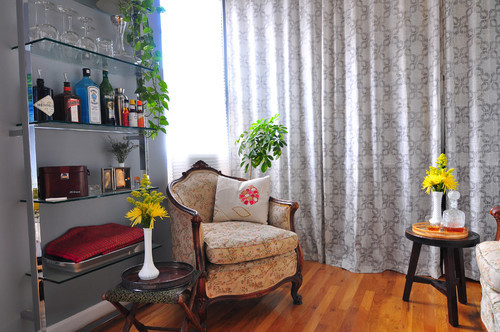
Eclectic Living Room by Austin Interior Designers & Decorators Scheer & Co.
Eliminate the dog or cat smell.
Living in a pet-friendly building is often considered an amenity to dog and cat owners, but you don’t want to smell a dog or cat when you enter your home. Be sure to keep the litter box extra tidy, and bathe your dog if he needs it. Use air fresheners, candles, and home fragrances to keep your nest smelling fresh for any lookers or buyers.
The post Stage Right: How to Get Your Apartment Ready to Sell appeared first on | Elika Real Estate.
January 16, 2015
6 Reasons Why an Expediter Is Essential if You Plan to Renovate in NYC
The road to renovation is a long one, and in New York City, the thick red tape you’ll have to cut through before you can sling a hammer may require some strategy. Enter the expediter.
If you’re not familiar with the term, an expediter is a sort of middleman between you, your project team (architect, designer, general contractor) and the Department of Buildings. You’ll require a building permit to begin construction and the expediter secures the necessary paperwork so you don’t have to. Sound like snap? Think again. Just one day at the office of the DOB and you’ll easily understand these six reasons you should hire an expediter.
1. Expediters know the drill.
They’ve been dealing with the DOB and know what’s required to secure the necessary permits. They’re familiar with the permitting process in New York City, familiar with building codes and what the DOB expects.
2. Expediters can evaluate architectural plans.
These guys (and gals) are building consultants, and not merely people who wait in line to be seen and heard. A good expediter can analyze your plans before they ever intend to pay a visit to the DOB. In the end, going in with a complete set of drawings with all the necessary information will save you time and money.
3. Expediters are connected.
They spend much of their time meeting with the people employed by the DOB. They know them, their quirks, and what it takes to get your plans approved so construction can begin. They’ve built relationships with them, and this will only expedite the process and get your project underway sooner rather than later.
4. Expediters can alleviate stress for you.
Renovating is a stressful process and you’ll have enough decisions to make. You’ll also probably have to go to work to pay for the renovation. You probably won’t have the liberty of ignoring your job or calling in sick for a week so you can wait in line as your workload piles up, only to try and decipher what’s needed to get a building permit. Leave it to the pros.
5. Getting a permit takes time you probably don’t have.
According to an article in the New York Times from December 2014, the average wait from the time the building package is filed with the DOB and the time the expediter meets with an examiner is 3.8 days. Note that this time is only for the initial meeting and not follow-up meetings.
6. Expediters will make it happen faster.
Because of items 1, 2, and 3 mentioned above, your expediter would secure the permit faster than you could. This means one thing: your project will finish sooner because it will begin earlier.
Know that you’ll still need to be involved with the expediter. Although your architect may recommend someone, if you choose to wash your hands of the process, he or your contractor may charge you an additional fee, which could be as much as 10 percent.
The post 6 Reasons Why an Expediter Is Essential if You Plan to Renovate in NYC appeared first on | Elika Real Estate.
January 13, 2015
5 Reasons Why Searching for a Sponsor Unit in a Co-op Might Be Worth Your Time
A sponsor unit might be your ticket to owning a slice of the Big Apple. Retained by an original owner of the building before it turned co-op, a sponsor apartment carries its share of advantages.
Usually located in prime Manhattan neighborhoods like the Upper East Side and Upper West Side, hunting for a sponsor sale could be worth your time, after all. These five reasons make it clear why so many New York City real estate buyers look long and hard for a sponsor unit.
No board interview
Skipping the standard co-op board interview is one of the main benefits of buying a sponsor apartment. Questions can be intrusive, requiring applicants to reveal personal information such as income and other financial data to a group of strangers, often judging on numbers only.
Even if you dodge the board interview, you may be required to chat with the sponsor. However, this meeting is usually not as invasive as a typical co-op board interview.
Less money down
Many co-ops require a 25 or 30 percent down payment, but when you buy a sponsor apartment, you can get away with the minimum required by the bank, which is often 20 percent. Less money down means less penny-pinching for you, so you might be able to make that purchase sooner than you’d thought. A smaller amount of down money will leave more cash in the bank after the closing, which brings me to the next point.
Less cash required after closing
Different co-op buildings require different reserve funds after you close on the apartment (could be up to two years mortgage and maintenance in the bank). By purchasing a sponsor unit, you might slide on this one, and your reserve terms could be substantially lower, such as one year of maintenance payments. Most often, if you qualify for the bank loan, you’re home free and can expect to be the proud owner of sponsor apartment.
Many original details
Because most sponsor units are prewar, they most likely come complete with original details such as hardwood floors with inlay, decorative moldings, tall ceilings, and original doors and hardware. These elements are not only selling points, but also desirable to anyone searching for a classic prewar residence, which could be you, or a potential buyer when you go to sell.
Certain rules may not apply
Known for their rules, co-op buildings differ from one to the next. If you purchase a sponsor apartment, however, you might be in luck and could possibly be exempt from some of these statutes, such as owning a pet or a particular size dog, or installing a washer/dryer in your unit. Check with the sponsor to get details before proceeding with the sale.
Pricing is one thing to consider before actively searching for a sponsor unit. Sales prices could be as much as 20 percent higher if the apartment comes renovated. Flats requiring full renovation could be only slightly higher than non-sponsor units.
When you’re buying a sponsor apartment in a co-op, you’ll avoid much of the aggravation during the process. Just know in the end, your dream apartment in NYC may cost a little more.
If a building was built before 1945, it is considered pre-war. At 10-20 stories tall, they are mid-size as far as apartment buildings go. Some A contract between a lending institution and a borrower to insure repayment of a loan. The components of a mortgage are the amount A contract between a lending institution and a borrower to insure repayment of a loan. The components of a mortgage are the amount A property that has multiple ownership by all its tenants/owners. The owners actually own shares
The post 5 Reasons Why Searching for a Sponsor Unit in a Co-op Might Be Worth Your Time appeared first on | Elika Real Estate.
January 10, 2015
Uptown Life: Should I Live on the Upper East or the Upper West?
So you’ve scratched downtown from your list and narrowed your future home to somewhere uptown. Tightening the search is a huge accomplishment, but you’ll still need to choose between the Upper East Side and the Upper West Side. If you assume these two nabes north of 59th Street are carbon copies, you couldn’t be more wrong. Each has its own distinct personality as well as positive and negative selling points.
Carl Schurz Park, luxury boutique shopping on Madison Avenue, Fairway, a new Whole Foods Market on the way, and a plethora of neighborhood bars are a few of the advantages of living east.
The Upper East Side has long had a reputation for being posher than its west side neighbor, with some of the most expensive apartments and exclusive buildings in the city on Park Avenue and Fifth Avenue. This is a fact, but Yorkville (stretching from East 79th to East 96th, Third Avenue to the East River), is a more affordable section that attracts a slew of post-college New Yorkers and young professionals.
Living at First Avenue or York Avenue is less expensive, but a long haul to the Lexington Avenue Subway. In a few years, however, the Second Avenue Subway will be up and running, providing East Siders with another train option.
That being said, currently, deals can be had near Second Avenue if you don’t mind temporary noise, construction and debris related to the new train –– supposedly until 2016. (I had the pleasure of living at First Avenue for two years when the mess began, and I moved clear across town to get away.)
Any apartment near the zone will more than likely cost less than those a few blocks away, so if you can handle the hassle, you can probably save some cash. Once the subway is complete, you’ll have a smart investment on your hands since property values will most likely increase after the new train line is up and running.
Other perks to being an Upper East Sider include Central Park, a growing restaurant scene, and more space for the money as compared to the Lower East Side.
Life on the Upper West Side will generally be more laid back, in general. Expect a more diverse, liberal crowd than across town. This section of uptown is home to artists, musicians, writers, professors, and other creative types. The area is characterized by grand prewar apartment buildings and blocks of charming brownstones.
Riverside Park along the Hudson River always provides great ambiance and wide-open spaces. The park boasts some lovely features, such as the 91st Street Garden (featured in You’ve Got Mail), the Soldier & Sailor’s Monument at 89th Street, and the 79th Street Boat Basin, a dog-friendly bar and restaurant which overlooks the Hudson River.
Interesting boutiques line Columbus Avenue in the West ‘70s, and you’ll find a good number of retailers on Broadway, including Century 21 near the south end of the neighborhood.
Shopping at Zabar’s can’t be beat. The 80-year-old institution is loved by Upper West Siders –– patrons travel near and far for the spot’s delicacies.
A walk east to Central Park is speedier than the comparable walk across town. After living in both the Upper East and the Upper West, I can vouch. Reaching Central Park from the farthest point on the Upper West Side takes no more than 15 minutes. Traveling on foot from the farthest street on the Upper East –– East End Avenue –– to Central Park is a 20-minute walk, minimum.
The Upper West Side isn’t known for its dining scene, but a handful of reputable restaurants have opened in the past couple years. Overall, the East Side wins when it comes to food and nightlife.
But the amount of culture on the UWS can’t be beat. The east side does proudly include Museum Mile and the 92nd Street Y, but on the west side, you can’t ignore the many performance options at Lincoln Center, a hub for the arts and home to Julliard.
The American Museum of Natural History lies in the heart of the neighborhood, as does the Historical Society, and the Mannes School of Music, with the Museum of Art & Design and The American Folk Art Museum is near Columbus Circle, while Symphony Space is located toward 96th Street.
Subway lines run on Central Park West and Broadway, offering more options than the sardine-like trains across town, making for a more pleasant commute.
A property that has multiple ownership by all its tenants/owners. The owners actually own shares
The post Uptown Life: Should I Live on the Upper East or the Upper West? appeared first on | Elika Real Estate.

















